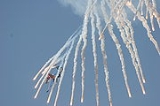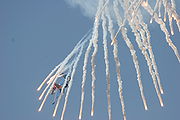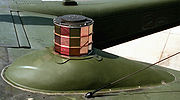
IRCM
Encyclopedia

Infrared homing
Infrared homing refers to a passive missile guidance system which uses the emission from a target of electromagnetic radiation in the infrared part of the spectrum to track and follow it. Missiles which use infrared seeking are often referred to as "heat-seekers", since infrared is just below the...
("heat seeking") missiles by confusing the missiles' infrared
Infrared
Infrared light is electromagnetic radiation with a wavelength longer than that of visible light, measured from the nominal edge of visible red light at 0.74 micrometres , and extending conventionally to 300 µm...
guidance system so that they will miss their target.
History
First deployed during the Vietnam WarVietnam War
The Vietnam War was a Cold War-era military conflict that occurred in Vietnam, Laos, and Cambodia from 1 November 1955 to the fall of Saigon on 30 April 1975. This war followed the First Indochina War and was fought between North Vietnam, supported by its communist allies, and the government of...
, they have been enhanced over the years to be lighter, more portable, and more reliable, but the basic principle is the same.
Infrared missile seeker technology
Infrared missile seekers of the first generation typically used a spinning reticle with a pattern on it that modulates infrared energy before it falls on a detector (A mode of operation called Spin scan). The patterns used differ from seeker to seeker, but the principle is the same. By modulating the signal, the steering logic can tell where the infrared source of energy is relative to the missile direction of flight. In more recent designs the missile optics will rotate and the rotating image is projected on a stationary reticle (a mode called Conical scan) or stationary set of detectors which generates a pulsed signal which is processed by the tracking logic.Most shoulder launched (MANPADS) systems use this type of seeker, as do many air defense systems and air to air missiles (for example the AIM-9L).
IRCM principles

Jet engine
A jet engine is a reaction engine that discharges a fast moving jet to generate thrust by jet propulsion and in accordance with Newton's laws of motion. This broad definition of jet engines includes turbojets, turbofans, rockets, ramjets, pulse jets...
in modern military aircraft). IRCM systems are based on modulated source of infrared radiation with a higher intensity than the target. When this modulated radiation is seen by a missile seeker, it overwhelms the modulated signal from the aircraft and provides incorrect steering cues to the missile. The missile will begin to deviate (wobble) from the target, rapidly breaking lock. Once an infrared seeker breaks lock (they typically have a field of view of 1 - 2 degrees), they rarely reacquire the target. By using flares
Flare (countermeasure)
A flare is an aerial infrared countermeasure to counter an infrared homing surface-to-air missile or air-to-air missile. Flares are commonly composed of a pyrotechnic composition based on magnesium or another hot-burning metal, with burning temperature equal to or hotter than engine exhaust...
, the target can cause the confused seeker to lock onto a new infrared source that is rapidly moving away from the true target.
The modulated radiation from the IRCM generates a false tracking command in the seeker tracking logic. The effectiveness of the IRCM is determined by the ratio of jamming intensity to the target (or signal) intensity. this ratio is usually called the J/S ratio. Another important factor is the modulation frequencies which should be close to the actual missile frequencies. For spin scan missiles the required J/S is quite low but for newer missiles the required J/S is quite high requiring a directional source of radiation (DIRCM).
Drawbacks of IRCM
One of the drawbacks of standard IRCM systems is that they broadcast a bright source of infrared. If the modulation of the signal is not effective against a particular seeker system, the IRCM will enhance the ability of the missile to track the aircraft. The aircrews typically brief about potential threats and choose an IRCM modulation that will be effective against likely threats.Directional IRCM
DIRCM, or Directional Infrared Countermeasures, avoid this potential drawback by mounting the energy source on a movable turret (much like a FLIR turret). They only operate when cued by a missile warning system of a missile launch, and use the missile plume to accurately aim at the missile seeker. The modulated signal can then be directed at the seeker, and the modulation scheme can be cycled to try to defeat a variety of seekers. Countermeasure success depend on threat's tracking techniques and requires threats' analysis capabilities. Defeating advanced tracking systems requires a higher level of DIRCM power. Issues of Laser SafetyLaser safety
Laser safety is safe design, use and implementation of lasers to minimize the risk of laser accidents, especially those involving eye injuries. Since even relatively small amounts of laser light can lead to permanent eye injuries, the sale and usage of lasers is typically subject to government...
are also taken into account.
Israel has announced a program to develop a system called Multi Spectral Infrared Countermeasure (MUSIC) that will similarly use active laser
Laser
A laser is a device that emits light through a process of optical amplification based on the stimulated emission of photons. The term "laser" originated as an acronym for Light Amplification by Stimulated Emission of Radiation...
s instead of flares
Flare (countermeasure)
A flare is an aerial infrared countermeasure to counter an infrared homing surface-to-air missile or air-to-air missile. Flares are commonly composed of a pyrotechnic composition based on magnesium or another hot-burning metal, with burning temperature equal to or hotter than engine exhaust...
to protect civilian aircraft against MANPADs. The US Army is deploying a similar system to protect its helicopter
Helicopter
A helicopter is a type of rotorcraft in which lift and thrust are supplied by one or more engine-driven rotors. This allows the helicopter to take off and land vertically, to hover, and to fly forwards, backwards, and laterally...
s.
Department of the Navy Large Aircraft Countermeasures (DoN LAIRCM) by Northrop Grumman provides infrared threat protection for U.S. Marine Corps CH-53E, CH-46E and CH-53D platforms.
BAE Systems' AN/ALQ-212 advanced threat infrared countermeasures (ATIRCM) - part of a directable infrared countermeasures suite - is fielded on U.S. Army CH-47 Chinook helicopters. The suite provides protection against an array of threats, including all infrared threat bands. The AN/ALQ-212 incorporates one or more infrared jam heads to counter multiple missile attacks.
CIRCM (Common Infrared Countermeasures)
CIRCM will be a laser based IR countermeasures solution against current and future IR threat systems for the US Army rotorcraft & fixed wing platforms and US Navy and US Air Force rotorcraft platforms. Currently, systems by BAE Systems, ITT Defense and Information Solutions, http://www.es.northropgrumman.com/circm/Northrop Grumman and Raytheon are under consideration.Flares
Flares create infrared targets with a much stronger signature than the aircraft's engines. The flares provide false targets that cause the missile to make incorrect steering decisions. The missile will rapidly break off a target lock-on.Fielded examples
Typical IRCM systems are the:- AN/AAQ-24 by Northrop Grumman - DIRCM.
- AN/ALQ-132 by Sanders/BAE Systems. Used in the 1960s in Vietnam, and was a fuel fired flashlamp system.
- AN/ALQ-144 by BAE Systems, used for helicopter defense.
- AN/ALQ-157 by BAE Systems, used for larger helicopters and aircraft.
- AN/ALQ-212 by BAE Systems, currently fielded on U.S. Army CH-47 Chinook helicopters.
- CAMPSCAMPSCivil Aircraft Missile Protection System or CAMPS is an infrared countermeasure against infrared-homed anti-aircraft missiles, specifically designed to defend civilian aircraft flying under against MANPADS....
by SaabSaabSaab AB is a Swedish aerospace and defence company, founded in 1937. From 1947 to 1990 it was the parent company of automobile manufacturer Saab Automobile, and between 1968 and 1995 the company was in a merger with commercial vehicle manufacturer Scania, known as Saab-Scania.-History:"Svenska...
Avitronics, used for civilian and VIPVery Important PersonA Very Important Person, or VIP is a person who is accorded special privileges due to his or her status or importance.Examples include celebrities, heads of state/heads of government, major employers, high rollers, politicians, high-level corporate officers, wealthy individuals, or any other...
aircraft. - CIRCM by Northrop Grumman
- Flight GuardFlight GuardFlight Guard is an Elta Systems Ltd's brand name for a family of airborne systems for protecting civilian aircraft against man-portable air-defense systems.-Description:...
by Israel Aerospace Industries, used in military and civilian aircraft (gain the nickname of "Live Saver" due to history of success in saving air vehicles during battles at several countries) , but banned at several European airports. According to defense sources in Israel, the European ban is "odd and based mostly on a misunderstanding - ITT's CIRCM System
- "Sukhogruz" - Russian DIRCM (used on Su-25T)
See also
- Infrared signatureInfrared signatureThe term infrared signature is used by defense scientists and the military to describe the appearance of objects to infrared sensors. An infrared signature depends on many factors, including the shape and size of the object, temperature and emissivity, reflection of external sources from the...
- CountermeasureCountermeasureA countermeasure is a measure or action taken to counter or offset another one. As a general concept it implies precision, and is any technological or tactical solution or system designed to prevent an undesirable outcome in the process...
- Flare (countermeasure)Flare (countermeasure)A flare is an aerial infrared countermeasure to counter an infrared homing surface-to-air missile or air-to-air missile. Flares are commonly composed of a pyrotechnic composition based on magnesium or another hot-burning metal, with burning temperature equal to or hotter than engine exhaust...
- Chaff (radar countermeasure)Chaff (radar countermeasure)Chaff, originally called Window by the British, and Düppel by the Second World War era German Luftwaffe , is a radar countermeasure in which aircraft or other targets spread a cloud of small, thin pieces of aluminium, metallized glass fibre or plastic, which either appears as a cluster of secondary...
- Electronic countermeasuresElectronic countermeasuresAn electronic countermeasure is an electrical or electronic device designed to trick or deceive radar, sonar or other detection systems, like infrared or lasers. It may be used both offensively and defensively to deny targeting information to an enemy...
- Anti-aircraftAnti-aircraft warfareNATO defines air defence as "all measures designed to nullify or reduce the effectiveness of hostile air action." They include ground and air based weapon systems, associated sensor systems, command and control arrangements and passive measures. It may be to protect naval, ground and air forces...
- Anti-ballistic missileAnti-ballistic missileAn anti-ballistic missile is a missile designed to counter ballistic missiles .A ballistic missile is used to deliver nuclear, chemical, biological or conventional warheads in a ballistic flight trajectory. The term "anti-ballistic missile" describes any antimissile system designed to counter...

